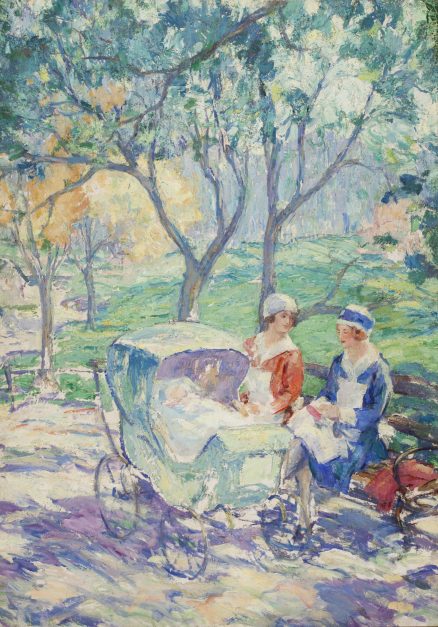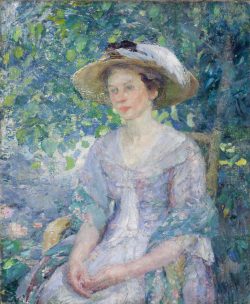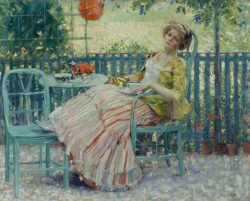- Categories
- Immigrant artists
- Landscapes
- Women
- Zoom in on Artwork
- Print Page
- Email Page to Friend
Identifiable as hired nursemaids by their white-aproned outfits, two young women sit together on a bench, a capacious baby carriage in front of them, in Karl Buehr’s park scene. The woman in blue lowers her gaze as she looks toward her infant charge, while her companion turns toward her attentively. Behind the pair, undulating green turf, a park path, and trees fill the distance. The scene is cast in patchy sunlight, with nearby trees throwing jagged shadows across the foreground. The painting’s vertical format compresses the view, focusing attention on the women, who are viewed from slightly above as if by a passing observer.
The rich color, broad paint handling, and attention to sunlight effects that characterize this work reflect Buehr’s time spent working in the international colony of impressionist painters in Giverny, France, between 1909 and 1912. There, he came to specialize in images of women posed out-of-doors in garden settings; he also painted numerous pure landscapes. Unusual for Buehr, this work combines the two: the women are scaled to fit into their surroundings rather than dominating the scene, and their interaction is subordinated to the dramatic play of light at their feet. The artist’s typical manner of applying paint in decorative patterned strokes gives way here to a variety of brushwork techniques ranging from thick, broadly applied pigment, as on the pale green baby carriage, to thin overlapping washes, seen on the blue dress. In some places, he barely filled in areas with color, leaving the underpainting clearly visible. Such spontaneous effects suggest Buehr’s awareness of recent artistic trends toward the use of color, texture, and line for more purely expressive ends. By the mid-1920s, the Art Institute of Chicago, where the artist was an instructor as well as a regular exhibitor, was increasingly sympathetic to modernism.
This work is also unusual for Buehr in the topical note struck by the dress and evident status of the female subjects. The artist typically favored somewhat eccentric clothing in his images of women at leisure, as seen in A Restful Moment. In contrast, the nursemaids’ uniforms seen here are prosaic working attire; probably dating to the 1920s, they precisely define the women’s occupations and social positions. Although the post–World War I era saw a shift away from the widespread employment of domestic servants in middle-class American households, particularly for childcare, nursemaids remained a symbol of status for the well-to-do. Buehr’s image reflects the renewed emphasis on domesticity and the family that marked American society in the wake of the war.
Wendy Greenhouse, PhD
Donated by M. Christine Schwartz to Lake Forest College, Lake Forest, Illinois, in 2021


